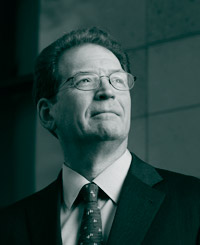SPRING 2013 CONTENTS
Home
Vital fluid
What we know about blood
Roll up your sleeve
There's still no substitute for blood
Life of blood
A guide to the cells coursing through your veins
Blood quest
The battle to protect transfusions from HIV
Against the flow
What's behind the decline in Blood transfusions?
Blood, sweat and fears
A common phobia's odd pathophysiology

DOWNLOAD PRINTABLE
ISSUE (PDF)


Glenn Matsumura

As a surgeon, I have become accustomed to the sight of blood. Mostly, it just gets in the way, obscuring the view of what really matters.
You try to look past it, hoping for a textbook view. But it’s constantly there, bright red, flowing effortlessly, a messy reminder of the vitality of human life and its remarkable capacity for regeneration. This issue of Stanford Medicine magazine is all about this liquid of life.
On Dec. 1, I became dean of the Stanford University School of Medicine. As the new blood, I’m enjoying getting to know better this amazing institution. At Stanford, our students love debating and discussing ideas. Through this magazine, thought leaders beyond our campus can join in this lively exchange of ideas on leading issues in biomedicine.
On campus we are now engaged in a lively discourse of our own about the future of Stanford Medicine. The challenges facing us in academic medicine are daunting. Society is demanding more from us — more value in health care, more scientific breakthroughs, more physicians ready for a rapidly changing health-care delivery and discovery environment. And yet we must face these growing challenges with fewer and fewer resources.
While many in academic medicine are hunkering down, our faculty and students are passionately pressing forward. Here at Stanford Medicine we see every day as opening up new possibilities, new ideas and new hope. As I consider our future, I am guided by three priorities: advancing innovation, empowering future leaders and transforming patient care.
Innovation is about the good ideas that change the world. At Stanford, our scientists are exceptionally creative. Last fall when the National Institutes of Health announced funding for its High Risk-High Reward program, researchers at Stanford received more awards than any other institution. But in a tough funding climate, we will have to work harder to attract and retain the most innovative faculty and students and give them the time and freedom they need to pursue the visionary science that can improve our lives.
If advancing innovation is in our blood, empowering future leaders is the legacy we leave to future generations. At Stanford we want our educational experience to be the best it can be, with integrated training opportunities for medical students, graduate students, postdoctoral scholars, residents and clinical fellows. As leaders in online education, we will share our interactive tools broadly with our peers so that we can enhance medical education and continuing medical education not just at Stanford but at schools across the country.
Last, but not least, we at Stanford will become a leader in the transformation of patient care by bringing the very best science to the treatment and prevention of disease, by focusing on the health and well-being of each patient who receives care through our system and by communicating our knowledge and advances to others.
I am delighted to be dean of such an outstanding institution, and I hope you will engage with us as we debate ideas and push forward, guided by our commitment to the priorities and principles that are our lifeblood: advancing innovation, empowering future leaders and transforming patient care. In closing, I thank the Stanford Blood Center for its partnership in producing this issue of Stanford Medicine magazine.
Sincerely,
Lloyd Minor, MD
Carl and Elizabeth Naumann Dean of the School of Medicine
Professor of Otolaryngology - Head & Neck Surgery

